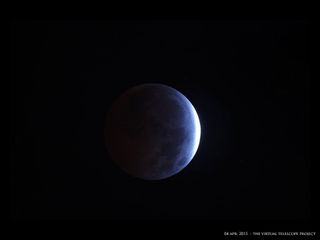
A lunar eclipse provides spectacular viewing opportunities for everyone, from amateur skywatchers to experienced observers — read on to learn how to describe what you see.
Here at Space.com, we are inviting our readers to make observations of the total lunar eclipse on Sunday to experience the amazing celestial event,
No matter whether you plan to watch this moon show for entertainment alone or make planned observations, you should be on alert for unusual happenings. In rare cases, the Earth's shadow projected onto the moon has had a zigzag shape, or there has been an abnormal pattern of darkness inside the umbra. If skies are clear, this should be a very extensively observed lunar eclipse because of the favorable combination of a weekend night, comfortable early-fall temperatures and visibility of the event from coast to coast. [Supermoon Lunar Eclipse on Sunday: When and How to See It]
If bad weather spoils your eclipse night on Sunday, you can watch the event live online. The Slooh Community Observatory will host a webcast at 8 p.m. EDT (midnight GMT) and feature expert commentary on the event. You can also watch the lunar eclipse webcast on Space.com, courtesy of Slooh.
Coloration and darkness

The brightness of the moon varies widely from one eclipse to another. One reason is that the moon sometimes passes through the darkest part of the Earth's shadow and, at other times, through the lighter outer umbra. But there is evidence of actual differences in the shadow from year to year. Thus, a careful description of the colors seen on the totally eclipsed moon and their changes is valuable.
The hues depend on the optical equipment used, usually appearing more vivid with the naked eye than in telescopes. In the early 20th century, French astronomer André Danjon introduced the following five-point scale of lunar luminosity ("L") to classify eclipses:
- L = 0: Very dark eclipse, moon almost invisible, especially in mid-totality.
- L = 1: Dark eclipse, gray or brownish coloration, details distinguishable only with difficulty.
- L = 2: Deep red or rust-colored eclipse, with a very dark central part in the shadow, and outer edge of the umbra relatively bright.
- L = 3: Brick-red eclipse, usually with a bright or yellow rim to the shadow.
- L = 4: Very bright copper-red or orange eclipse, with a bluish, very bright shadow rim.
Estimates of this "Danjon number" form a long-standing record of lunar-eclipse brightnesses, so they are well worth continuing even in this age, when brightness can be measured more precisely by photoelectric photometry. Visual estimates made by large numbers of people at the same time as photometric measures serve to calibrate decades of past observations. [Supermoon Lunar Eclipse of 2015: Visibility Maps]
Get the Space.com Newsletter
Breaking space news, the latest updates on rocket launches, skywatching events and more!
To judge the Danjon number, you can use your naked eye, binoculars or a small telescope at low power. A fractional estimate, such as 1.8 or 2.5, may seem the most appropriate. Try to make three measurements: Examine the moon at mid-totality and also near the beginning and end of totality to get an impression of both the inner and outer umbrae.
Another simple numerical scale for grading the brightness of total eclipses of the moon was proposed by Willard J. Fisher in 1924. It does not involve color but rather the visibility of surface features inside the umbra. Fisher gave the following definition of his scale:
- Grade 2: When the naked eye sees "spots" on the eclipsed moon, or the seas and other detail can be seen with hand instruments like opera glasses, field glasses and spyglasses.
- Grade 1: When instruments with apertures between 2 inches and 6 inches (5 to 15 centimeters) are necessary to show detail on the eclipsed surface.
- Grade 0: When apertures of 6 inches (15 cm) or more are needed.
Moon vs. stars and planets
Another procedure is to estimate the stellar magnitude of the moon during totality by comparing its brightness to the other bodies in the sky. When it's faintest, at mid-totality, the moon may be similar in brightness to naked-eye planets or prominent stars. To see the moon and stars as comparable disks, some nearsighted observers need only remove their glasses. Another technique is to view both the eclipsed moon and comparison stars simultaneously through binoculars held backward, so that the large objective lenses are nearest to the eyes.
Breathtaking darkness
At mid-totality, the darkness of the sky is very impressive. Faint stars, which were completely washed out by the brilliant moonlight prior to the eclipse, become visible. The surrounding landscape takes on a somber hue. As totality ends, the eastern edge of the moon begins to emerge from the umbra, and the sequence of events repeats in reverse order until the spectacle is over.
Unless airborne volcanic aerosols or other unusual atmospheric effects influence its appearance, the moon's disk should appear moderately bright, especially right around the beginning and end of totality. The lower part of the moon will likely appear brightest and glowing aruddy or coppery hue, while the upper half of the moon should look more gray or chocolate in color.
Good luck, and clear skies!
Editor's note: If you capture an amazing view of Sunday night's total lunar eclipse that you'd like to share for our upcoming column or image gallery, send the images to managing editor Tariq Malik at spacephotos@space.com.
Joe Rao serves as an instructor and guest lecturer at New York's Hayden Planetarium. He writes about astronomy for Natural History magazine, the Farmer's Almanac and other publications, and he is also an on-camera meteorologist for News 12 Westchester, New York. Follow us @Spacedotcom, Facebook and Google+. Original article on Space.com.
Join our Space Forums to keep talking space on the latest missions, night sky and more! And if you have a news tip, correction or comment, let us know at: community@space.com.

Joe Rao is Space.com's skywatching columnist, as well as a veteran meteorologist and eclipse chaser who also serves as an instructor and guest lecturer at New York's Hayden Planetarium. He writes about astronomy for Natural History magazine, the Farmers' Almanac and other publications. Joe is an 8-time Emmy-nominated meteorologist who served the Putnam Valley region of New York for over 21 years. You can find him on Twitter and YouTube tracking lunar and solar eclipses, meteor showers and more. To find out Joe's latest project, visit him on Twitter.

